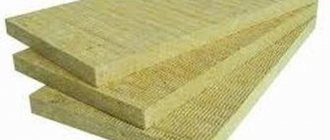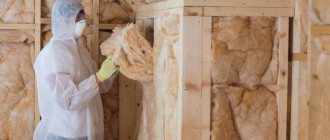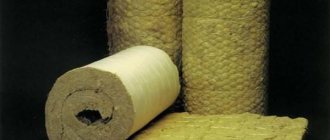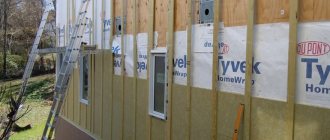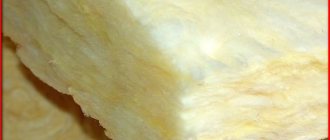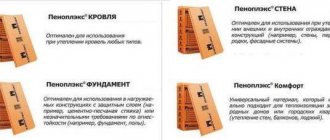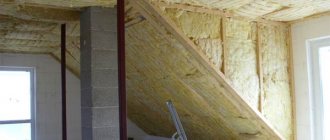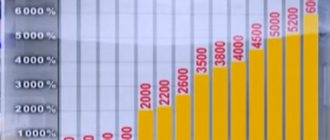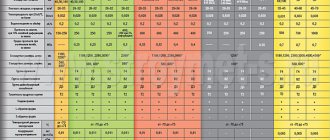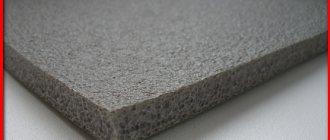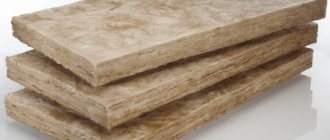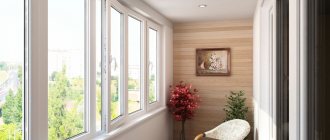Influence of insulation density on performance characteristics
To insulate a room from the outside or inside, an important indicator is the density of the material.
Density affects the following parameters of the material used for wall insulation:
- declared thermal insulation properties;
- quality of sound insulation;
- resistance to deformation;
- installation features under certain work conditions.
For any heat insulator, the rule is: the less it weighs (the lower its density), the more convenient the material is for installation, and therefore more preferable. The density factor of stone wool is assessed by experts with great reservations. Its low thermal conductivity is due to the presence of an air gap between the threads. When this indicator reaches a certain minimum, the material ceases to retain heat.
When evaluating a material, it is always taken into account that the density of mineral wool affects not only its weight, but is also directly related to other performance characteristics.
Types of mineral wool
Table of types of mineral wool.
When talking about mineral wool, you need to keep in mind that its very definition is not entirely correct. According to GOST 52953-2008, the mineral wool class includes 3 types of insulation: glass wool, slag wool and stone wool.
They differ in the length and thickness of the fibers, therefore they have different performance characteristics, including density. Therefore, they have different thermal conductivity, load resistance, water resistance and fire resistance.
The basis of glass wool is fibers with a thickness of 5 to 15 microns and a length of 15 to 50 mm. Thanks to them, glass wool becomes an elastic and fairly durable material, and it is also much cheaper than other types of mineral wool.
The main inconvenience when working with it is the need to work in protective equipment all the time: a protective suit, thick gloves, goggles and a respirator. The reason for this is the fragility of glass threads. They break easily and dig into unprotected skin, injuring it. And glass dust, if it gets into the eyes or lungs, can cause serious injuries to a worker, including disability.
Comparative characteristics of different types of mineral wool.
Slag wool is made from blast furnace slag, the fiber size is 16 mm, and the thickness is from 4 to 12 microns. Although this insulation is not as dangerous as glass wool, its fibers are also quite brittle, so it is inconvenient to work with it without gloves.
Slag wool cannot be used in damp rooms, since any slag has a certain residual acidity, which, when in contact with moist air, will have an aggressive effect on metal structural elements.
Slag wool is not suitable for insulating facades because it is very hygroscopic. For the same reason, it is not suitable for thermal insulation of water supply and sewerage pipes, regardless of whether they are plastic or metal.
In stone wool, the fiber sizes are practically no different from the sizes of slag wool fibers. But, unlike the latter, they are much stronger, therefore, they almost do not break during operation, so it is almost safe to work with it. Therefore, in the construction literature, the definition of “mineral wool” most often means stone wool.
Return to contents
Basic criteria and building standards
The lower the density of mineral wool, the lower the thermal conductivity and the higher the sound insulation.
The thermal transfer resistance of the walls of buildings under construction is regulated by the current standards of SNB 2.04.01 (Chapter 5.1), which provides information for all types of walls and ceilings. In addition, for external fences and coatings, parameters for air and vapor permeability must be calculated. In multilayer protective structures, the materials used are calculated as a single whole, consistent with the main technical indicators.
The selection of products that are supposed to be used to insulate walls is preceded by thermal engineering calculations. Based on their results, the type of material needed and its specific brand are determined. When using synthetic substances (polystyrene or polyethylene), it is taken into account that they are impermeable not only to water, but also to steam. Therefore, when choosing them, it will be necessary to take special measures to create good air exchange in the rooms.
Materials formed into slabs (including glass wool) have special requirements:
- the geometry is chosen so that the corners and edges of the workpieces do not have clearly visible damage and noticeable irregularities;
- the structure of the slabs is dense, the presence of poorly connected fibers and falling out granules is considered completely unacceptable;
- the surfaces on both sides are made rough, or one of them is made with a complex texture.
Fulfillment of the last requirement guarantees good adhesion to insulated walls.
Thermal conductivity and density - how are they related?
It is quite difficult to understand what the density of insulation affects, because... this indicator has virtually no direct effect on thermal conductivity. At the same time, when choosing insulation, you should definitely take into account the density.
In any heat-insulating material, air, in a normal or discharged state, is the main heat insulator. The more air there is in the thermal insulation material, and the better it is insulated from contact with outside air, the lower the thermal conductivity coefficient will be.
When comparing expanded polystyrene and mineral wool, their different structure should be noted. Polystyrene foam consists of polystyrene foam balls filled with air. Therefore, changes in density in the foam structure have virtually no effect on the level of thermal conductivity in this material.
Mineral wool consists of interwoven fibers with air between them. The lower the density of the structure of this material, the more air there will be in it, and thus the thermal conductivity of this material will be lower. With a denser material structure, the thermal conductivity will be higher, because it contains less air.
Heat transfer resistance coefficient
When everything is clear about the scope of application of each thermal insulation material, the most effective possible option for this design is determined.
Heat loss through the structural elements of buildings is affected by the thickness of the material used and its heat transfer resistance coefficient - the ability to transmit heat. The lower the thermal conductivity coefficient and the thicker the layer of building material, the better the heat is retained.
To visually represent the required thickness of walls made of a homogeneous material that meets the requirement for heat transfer resistance, we made a calculation that takes into account the thermal characteristics of the building materials used. See the results obtained in the graph:
- Expanded polystyrene
- Mineral wool
- Gas silicate block
- Solid wood
- Expanded clay concrete
- Brick
To choose the most economical option, you should pay attention to the thermal conductivity coefficient of building materials in the thickness of the enclosing structures: external walls, flat or pitched roofs, attic roofs, attic floors, windows, foundations, wooden and concrete floors (see table 2). The lower this indicator, the smaller the thickness of the thermal insulation layer will be required.
Table 2 - thermal conductivity coefficient of building materials
| Name | Density, kg/m3 | Thermal conductivity* λ W/(m °С) under operating conditions**: | |
| A (dry mode) | B (normal mode) | ||
| Construction materials | |||
| Reinforced concrete | 2500 | 1,92 | 2,04 |
| Foam and aerated concrete | 1000-300 | 0,36-0,09 | 0,37-0,10 |
| Foam and gas silicate blocks | 1000-300 | 0,36-0,09 | 0,37-0,10 |
| Ceramic brickwork | 1800 | 0,70 | 0,81 |
| Lime-lime brick masonry | 2000-1600 | 1,36-0,69 | 1,63-0,81 |
| Masonry of hollow ceramic bricks (gross brick density 1400 kg/m3) | 1600 | 0,63 | 0,78 |
| Pine, spruce across (along) the grain | 500 | 0,14 (0,29) | 0,18 (0,35) |
| Regular glass | 2500 | 0.76 | |
| Double-glazed window 32 4M—10—4M—10-4M | 0,47 | ||
| Single-chamber double-glazed window 24 mm 4M—16—4M | 0,32 | ||
| Ruberoid (GOST 10923-82) | 600 | 0.17 | |
| Clay tiles | 1900 | 0.85 | |
| Gypsum plaster | 800 | 0.3 | |
| Insulating plaster | 500 | 0.2 | |
| Steel | 52 | ||
Table 3 - Comparison of thermal conductivity characteristics of insulation materials
| Name | Density, kg/m3 | Thermal conductivity* λ W/(m °С) under operating conditions**: | |
| A (dry mode) | B (normal mode) | ||
| Extruded polystyrene foam | 26-60 | 0,034-0,036 | 0,034-0,036 |
| Polyurethane foam | 80-40 | 0,05-0,04 | 0,05-0,04 |
| Stitched mineral wool mats | 125-50 | 0,046-0,042 | 0,051-0,045 |
| Mineral wool slabs with synthetic binder | 250-75 | 0,061-0,047 | 0,069-0,051 |
| Slab polystyrene (foam) | 50 | 0,043 | 0,052 |
| 35 | 0,041 | 0,05 | |
| 25 | 0,043 | 0,052 | |
| 15 | 0,045 | 0,054 | |
| Polystyrene concrete slabs | 300-230 | 0,092-0,075 | 0,10-0,085 |
| Expanded clay | 800-200 | 0,21-0,11 | 0,23-0,12 |
| Ecowool | 35-60 | 0.032-0.041 | |
*coefficient values were taken from Appendix A of TKP 45-2.04-43-2006, technical characteristics from thermal insulation manufacturers;
**in residential buildings, external enclosing structures refer to operating conditions B, and internal walls, partitions, attic and basement floors - to operating conditions A.
What determines the weight of the mineral wool used?
In the process of producing insulation, offered to customers under the general name of mineral wool, both basalt rocks can be used, which makes it possible to call the final product basalt wool, and waste from the metallurgical industry - slag, the weight of which is significantly less than basalt, which affects the weight of the insulation.
The weight of mineral wool depends on its density, which influences the choice of material depending on the area of application - loaded or unloaded surfaces. For the most part, this figure can range from 35 to 100 kg/cubic meter. Considering that the size of the insulation boards used is on average 0.6 square meters, the weight during installation is also insignificant. The term “density” in some cases can be replaced by the name “volumetric weight of the minislab”, which fully corresponds to the definition of density and represents the weight of 1 cubic meter of insulation.
Classification of mineral wool by density
The market is filled with offers from domestic and foreign manufacturers. To systematize hundreds of items, below is a list of materials produced in Russia that differ according to the criterion under consideration, as well as some recommendations for use.
P-75
The density of this brand of insulation is 75 kg/m3. A low indicator allows the use of wool only in lightly loaded surfaces, including horizontal ones (attic floors, pitched roofs). The material is more popular in the oil and energy industries - it is used to wrap pipes of heating plants, as well as joints of gas and oil pipelines.
There are insulation materials of lower density (15, 25, 40 kg/m3), but they are practically not used, because they lose their shape and properties even with minimal load.
P-125
The density of this mineral wool is 125 kg/m3. The material is good for covering ceilings, floors, walls, partitions, frame buildings in a temperate climate zone. In addition to decent thermal insulation properties, it perfectly suppresses extraneous noise.
PZh-175
Material of increased rigidity (this is reflected in the name). It is used for cladding walls or ceilings made of metal, reinforced concrete, concrete, brick.
PZh-200
It also has increased density (200 kg/m3), rigidity and is used in the same situations as the previous one. There is one advantage over the previously mentioned one - PZh-200 serves as additional fire protection.
Mineral wool slabs with a density of 75 to 200 kg/m3, described above, are quite sufficient for insulating any premises of a private or apartment building. However, on the market you can find unfamiliar markings for products manufactured abroad.
Classification of mineral wool produced in other countries:
- VL, TL (suitable for structures with a maximum load of 8 and 12 kN/m2, respectively);
- EL, ELD, ELUS (good for insulating concrete elements, maximum permissible load - 5 kN/m2);
- IM, IMP (rafters, floor structures, foundation);
- AKL, KKL (high-rigidity materials used for thermal insulation of pitched roofs);
- TKL (flat roof thermal insulation);
- VIL (reminiscent of AKL and KKL, but has cut corners; used if the roof needs to be sloped);
- TSL, VUL, IRL (thin slabs, used for wind protection of light structures - walls or rafters);
- ILP (pressed between elements of concrete, brick, metal buildings);
- A, IL (classic mineral wool boards used for wall insulation; recommended for areas where space for material is limited).
The specific density of the insulation is not indicated, since in terms of compatibility with various structures it is not difficult to compare its indicator with its domestic counterpart.
General classification of insulation
All thermal insulation materials are divided into several groups according to their density:
- especially light;
- lungs;
- average;
- hard (dense/heavy).
The first includes polystyrene foam (expanded polystyrene) - a material that has a structure of pores, inside of which there is air. Mineral wool is considered a lightweight insulation material. This material prevents an increase in the concentration of water vapor, therefore it is often used for thermal insulation of easily loaded surfaces indoors. However, the density of mineral wool can vary from a couple of tens to several hundred kg/m3; for this reason, it is classified as light only conditionally.
Classification of insulation by density level
Usually everyone remembers school physics and associates the density of insulation with weight and mass.
The heavier the better, but this does not always follow true, depending on what factors and what operating conditions.
The choice of insulation directly depends on the budget, as paradoxical as it may sound, and of course the load on the structure as a whole or on a specific element.
Based on the density of the material, the following classification is distinguished:
Extra light
These include polystyrene foam (expanded polystyrene), which has a porous structure.
Designed for insulation in the cavities of walls, partitions, and for unloaded elements of the house.
Lungs
These are insulation materials based on mineral wool. They have a low thermal conductivity coefficient. Widely used in the construction of private houses and cottages.
Average
These types usually include foam glass. It is in the form of blocks and slabs, with high thermal insulation and sound insulation properties. It is not widespread in Russia.
Dense or hard
They also contain mineral wool, tightly pressed under high pressure. This type of insulation is used for outdoor work and is resistant to moisture and mechanical stress.
Description and influence
Density is a value that is inversely proportional to the porosity of the insulation. Porous materials retain heat and create a kind of buffer. Therefore, the conclusion arises about how density affects: the higher the specific gravity, the less thermal insulation properties the insulator has.
A good example
For example, birch timber - 500-770 kg/m3, basalt fiber - 50-200 kg/m3. And the thermal conductivity coefficient of birch is 0.15 W with the same fiber index of 0.03-0.05 W. Thus, porous mineral insulation retains heat almost 5 times more efficiently than denser wooden beams.
It is precisely because of their specific gravity that even thick, reliable walls do not always provide good thermal protection. But a thin layer of insulation can correct this problem. In addition, low specific gravity gives less load on structures: cellular concrete with a low thermal conductivity coefficient of 0.1 W is not suitable for insulating thin walls and frame buildings since its density is almost 400 kg/m3.
Density provides resistance to mechanical stress, so insulators with low specific gravity require a protective layer. Such materials include penoizol, polystyrene foam and penoplex, as well as mineral wool.
How to choose the right insulation?
When choosing insulation, you need to pay attention to: affordability, scope of application, expert opinion and technical characteristics, which are the most important criterion.
Basic requirements for thermal insulation materials:
- Thermal conductivity.
Thermal conductivity refers to the ability of a material to transfer heat. This property is characterized by the coefficient of thermal conductivity, on the basis of which the required thickness of the insulation is taken. Thermal insulation material with low thermal conductivity is the best choice.
Also, thermal conductivity is closely related to the concepts of density and thickness of insulation, so when choosing, you need to pay attention to these factors. The thermal conductivity of the same material can vary depending on density.
Density insulation material. Based on density, materials are divided into: extra light, light, medium, dense (hard). Lightweight materials include porous materials suitable for insulating walls, partitions, and ceilings. Thick insulation materials are better suited for insulating the outside.
The lower the density of the insulation, the lower the weight, and the higher the thermal conductivity. This is an indicator of the quality of insulation. And the low weight makes installation and installation easy. In the course of experimental studies, it was found that insulation with a density of 8 to 35 kg/m³ best retains heat and is suitable for insulating vertical structures indoors.
How does thermal conductivity depend on thickness ? There is a misconception that thick insulation will better retain heat indoors. This leads to unnecessary expenses. Too much insulation thickness can lead to disruption of natural ventilation and the room will be too stuffy.
Table of densities of different insulation materials
The density of insulation is the value that determines the mass of one cubic meter of material. This indicator differs for different thermal insulation materials.
| Name | kg/m³ |
| Cellulose wool | 30-70 |
| Fiberboard | 150-230 |
| Linen mats | 30 |
| Foam glass | 100-150 |
| Cotton wadding | 25-30 |
| Mineral wool | 50-200 |
| Styrofoam | 25-35 |
| Extruded polystyrene foam | 35-40 |
| Polyurethane foam | 30-80 |
| Expanded clay | 450-1200 |
This insulation parameter is determined by the purpose of the thermal insulation.
Advantages and disadvantages of insulation
- Polyurethane foam – by far the most effective insulation.
Types of polyurethane foam
Advantages: seamless foam installation, durability, better heat and water insulation.
Disadvantages: high cost of material, instability to UV radiation.
- Expanded polystyrene (foam) – in demand for use as insulation for various types of premises.
Advantages: low thermal conductivity, low cost, ease of installation, water resistance.
Disadvantages: fragility, easy flammability, condensation.
- Extruded polystyrene foam is a durable and convenient material; if necessary, elements of the required size can be easily cut with a knife.
Advantages: very low thermal conductivity, water resistance, compressive strength, ease of installation, absence of mold and rot, ability to operate from -50⸰С to +75⸰С .
Disadvantages: much more expensive than polystyrene foam, susceptibility to organic solvents, condensation formation.
- Basalt (stone) wool – mineral wool made on a basalt base.
Advantages: resistance to the formation of fungi, sound insulation, mechanical strength, fire resistance, non-flammability.
Disadvantages: higher cost compared to analogues.
- Ecowool is insulation made from natural materials (wood fibers and minerals). Today it is used quite often.
Advantages: sound insulation, environmental friendliness, moisture resistance, affordable cost.
Disadvantages: thermal conductivity increases during operation, the need for special equipment for installation, and the possibility of shrinkage.
- Isolon is a modern insulation made by foaming polyethylene. It is one of the most popular.
Advantages: low thermal conductivity, low vapor permeability, high noise insulation, ease of cutting and installation, environmental friendliness, flexibility, light weight.
Disadvantages: low strength, need for a ventilation gap.
- Penofol - insulation that meets many requirements for the quality of insulation and insulation of various premises, as well as structures, etc.
Advantages: environmental friendliness, high ability to reflect heat, high noise insulation, moisture resistance, non-flammability, ease of transportation and installation, reflection of radiation exposure.
Disadvantages: low rigidity, difficulty in fastening the material; penofol alone is not enough as thermal insulation.
Rating of the best insulation for home
| Nomination | place | Name of product | price |
| The best basalt insulation | 1 | Rockwool | 695 ₽ |
| 2 | Hotrock Smart | 302 ₽ | |
| The best polystyrene foam insulation | 1 | Technicol XPS Technoplex | 1 100 ₽ |
| 2 | Penoplex Comfort | 980 ₽ | |
| The best foam insulation | 1 | Knauf Therm House | 890 ₽ |
| 2 | PSB S 15-O | 1 688 ₽ | |
| The best fiberglass insulation | 1 | Isover Warm House | 660 ₽ |
| 2 | Ursa Geo | 800 ₽ | |
| The best polyester fiber insulation | 1 | Shelter EcoStroy ShES Arctic | 1 780 ₽ |
Using wool of different densities for insulation
The choice of insulation according to the indicator under consideration depends on the place of its use. It is not always necessary to overpay in order to get the desired result. Most often, the facade, walls, roof and floor are insulated. These are the options that are worth considering.
Regardless of density, the material must be protected from moisture
Facade
When selecting insulation for a facade, you need to pay attention to the mass and density of mineral wool. For most buildings, weighting is very undesirable. It is also worth paying attention to the possibility of subsequent finishing, because this indicator also affects this. So:
- If the facade is equipped with a ventilated one, then a sufficient density is 45-100 kg m³. Here the cotton wool is laid into the sheathing and there will be virtually no stress. The main tasks for this type are to maintain its shape and not sag under its own weight, and the indicated indicator is enough for this.
- If the facade will be plastered over insulation, then the density should be above 100 kg m³, optimally from 145 to 165. This will allow the use of any types of plaster mixtures, including bark beetle, barenkom and even mosaics. Since this mineral wool will have to withstand heavy loads during installation, it must be securely fastened; for this, a system with dowels is used in combination with adhesive fastening.
Wall insulation
In this case, the selection is made based on ease of installation, that is, the density should be at least 30-45 kg m³. In this case, you need to insulate from the inside; MDF boards or drywall should be screwed onto the material on top. In order to mount such mineral wool, you need a lathing; rolls or sheets are placed in it.
Roof
Since roof insulation work is carried out at heights, the main criteria when selecting mineral wool are light weight and ease of use. Material with a density of 30-35 kg m³ can be pleased with these qualities. Its sound and heat insulation properties will be excellent, and at the same time light weight. Installation can be carried out using two methods:
- Using a construction stapler.
- In the lathing with a vapor barrier closure.
Selecting insulation density
Before deciding which insulation density to choose, you need to determine where it will be installed. If you plan to insulate the walls, the type of cladding plays an important role. It determines the type and density of the heat insulator. Thus, for a residential building it is recommended to use basalt wool, which has low thermal conductivity, high fire resistance and environmental friendliness.
For cladding with siding, a basalt heat insulator with values of 40-90 kg/m³ is suitable. The higher the thermal insulation is located, the higher the indicator should be. If the surface will be plastered, then you need to choose special thermal insulation for facade work. The density should be 140-160 kg/m³. For this work, special elements are used that have high vapor permeability and tear strength. For interior work, low-density thermal insulation material is used.
When doing roofing work, the choice of insulation depends on the type of roof. If the roof is pitched, choose insulation with values of 30-45 kg/m³. To insulate the attic, the indicator must be at least 35-40 kg/m³. A flat roof must withstand heavy loads caused by snow, wind and other atmospheric phenomena. Therefore, in this case, thermal insulation with a density of 150 kg/m³ should be used if mineral wool is used. For expanded polystyrene, this figure should be no more than 40 kg/m³.
To insulate the floor from the cold, you should choose a material whose mass pressure per unit volume is sufficiently high. However, if you plan to lay material between the joists, you can use loose insulation. The logs take on the entire load, and the thermal insulation is not tasked with withstanding the pressure exerted.
Recommendations for thickness and density of mineral wool
Various types of rigid mineral wool for facades are produced in the form of rolls or slabs with dimensions of 60x120, 60x100 or 50x100 cm, and the thickness of the product depends on its type and basic properties. Manufacturers produce products with material thicknesses ranging from 50 to 200 mm, while slabs with a thickness of 10 cm are most widely used in practice.
When choosing the thickness and density of slabs and rolls of rigid mineral wool for the facade, users use the information contained in the technical characteristics of the insulation, while builders carry out complex calculations on the weight of the rigidity and the durability of the material. Among the manufacturers' recommendations regarding the scope of application of rigid mineral wool, depending on its specific gravity, the following should be highlighted:
- the use of insulation having a density of about 35 kg/m3 is recommended when performing interior work and sound insulation on inclined, vertical unloaded enclosing structures, pitched roofs and floor finishing when using laminate flooring, solid boards, etc.;
- the use of insulation with parameters up to 75 kg/m3 (P75) is acceptable when finishing the ceiling, walls, floor and interior partitions;
- the use of mineral wool with a specific gravity of up to 100 kg/m3 is allowed when working with ventilated air gaps and external enclosing structures;
- when arranging facades and ventilated facade systems, it is recommended to use insulation, the density of mineral wool for the facade is 80–130 kg/m3 (P125);
- the use of insulation, the specific gravity of which is up to 150 kg/m3, is recommended when installing the bottom layer of thermal insulation in reinforced concrete structures;
- when finishing a “wet” facade, rigid mineral wool is used, the density of which ranges from 130-160 kg/m3, the strength of this material ensures reliability in bearing the weight of the applied plaster solution;
- the use of insulation having a specific gravity of up to 175 kg/m3 (P175) is practiced when making the main layer of thermal insulation for concrete structures;
- The use of mineral wool, which has increased rigidity (PPZh200) and a density of up to 200 kg/m3, is recommended when making the top layer of coatings when performing thermal insulation of floors under screed.
Types and selection
In general, all insulators can be divided into the following groups:
- dense – mineral wool under high pressure;
- medium - glass wool and polystyrene foam;
- light - mineral wool;
- very light - foam plastic boards.
To determine the type of insulation, you need to consider some factors.
For finishing in a residential building
Thus, for finishing walls and floors in a residential building, it is better to use basalt materials, which are distinguished not only by their optimal density, but also by their environmental friendliness. For basalt fiber, it can be different: for walls with siding cladding, it is better to use a material with a unit mass per unit volume of no less than 40 and no more than 90 kg/m3. This indicator should increase with the growth of the building: the more floors, the greater the rigidity.
Materials of 140-160 kg/m3 are suitable for working with plastered facades. Most often, special elements with high peel strength and vapor permeability are used. When insulation from the outside of the house is impossible, the procedure is carried out from the inside - density also affects here, insulators with a low density are needed. In both cases, mineral or glass fiber is suitable.
For roof and floor finishing
Thus, slabs for roofing insulation should have a low specific gravity. But it depends on the type of roof:
- a pitched roof requires slabs of 25-45 kg/m3;
- for the attic you need materials with a pressure of at least 35 kg/m3;
- a flat roof needs insulators that can withstand good mechanical loads - snow and wind, so basalt wool with 150 kg/m3, polystyrene foam with an indicator of more than 35 kg/m3 are suitable.
Extruded polystyrene foam is used for thermal insulation of the floor. If the insulation is carried out on joists, then mineral wool slabs can be used - rigidity is not particularly important, because the beams will take the pressure. Slabs of 50 kg/m3 are installed in the interior walls.
Penoizol and polyethylene
Penoizol has one significant difference from previous insulators - it is applied in liquid form and has a low density of 10 kg/m3, while its high porosity gives it good insulating properties. Foamed polyethylene can have different specific gravity - it depends on the availability of reinforcement and thickness:
- roll material is needed for floor insulation - 24 kg/m3;
- for frame buildings and insulation of refrigeration units, engineering structures, it is reinforced with aluminum sheets - 50-60 kg/m3.
Foam glass
Thus, foam glass has a thermal conductivity coefficient of 0.1 W and is much stronger than other insulation materials. The density indicator reaches 400 kg/m3 and the material is very stable - suitable for external thermal insulation without requiring a protective layer. Cellular glass has a wide range of materials:
- external insulation - 200-400 kg/m3;
- vertical structures – 200 kg/m3;
- roofs and foundations – 300-400 kg/m3;
- for light and frame structures – 100-200 kg/m3.
Thermal conductivity is 0.04-0.06 W and is almost similar to mineral insulation.
Rules for installing mineral wool slabs
Preparation for installing mineral wool slabs or rolls includes a number of procedures, among which the following should be highlighted:
- Cleaning surfaces from traces of mold using a construction spatula, if necessary, treating the surface with an antiseptic.
- Sealing of holes and cracks, carried out using cement mortar, sealing of deep voids with the help of polyurethane foam and tow.
- Treatment with antiseptic agents and primer, it is important to maintain the recommended time between applying different layers so that each of them has time to dry.
- At the last stage of preparation, the flatness of the surface is ensured, which is necessary for a tight fit of frameless insulation to it.
- After completion of preparation, an adhesive solution for fastening rolls applied in a spot manner ensures the creation of an air gap.
- Starting from the top of the wall in a horizontal direction, using a furniture stapler or double-sided tape, install the vapor barrier film to the frame.
- After this, the joints are glued using construction tape or mounting tape.
- Then the sheathing is carried out using slats having a width of about 1.5–2.5 cm, which is necessary to create a ventilation gap between the inner lining and the vapor barrier layer.
- At the next stage, the required length of the rigid mineral wool , taking into account a tolerance of 10 cm, and its installation on the surface of the facade by pressing the brackets on the frame with the bent ears, ensuring reliable fixation of the insulation in a vertical position.
- At the last stage of installation, the final finishing is carried out, for example, profiles are installed and sheets are installed, made of plasterboard or plaster is applied.
Note! Builders consider it more preferable than using material in rolls to use rigid mineral wool slabs for finishing vertical surfaces. This is due to the lack of rolling of the insulation, however, before installing it, it is recommended to first install the strips in a horizontal direction to reduce their weight.
Characteristics of mineral wool: density and thickness
The selection of rigid mineral wool with certain density indicators is carried out taking into account the characteristics of the object on which finishing work will be carried out. This condition is of particular importance, given that insulating a façade using a low-density material can lead to:
- reducing the thickness of mineral wool;
- the formation of unclosed areas and cracks;
- compaction of mineral wool used in façade finishing;
- changes in the dimensions of the material declared by the manufacturer.
Any type of wool is a product obtained as a result of special processing of stone, glass or slag. It is recommended to carry out insulation with each of the following types of material in accordance with the recommendations of specialists for finishing the facade, external or internal enclosing structures. According to the classification, there are 3 types of mineral wool heat-insulating substances:
- Basalt wool, which does not ignite but melts when interacting with fire, is characterized by low water absorption rates. Insulation of this type is used in conjunction with processing for decorative thin or thick-layer plaster, sound insulation and insulation of roofs, walls, ceilings, ventilated facades and the “wet facade” system. Its density varies depending on the type of product with a thickness of 50 mm in the range of 100–140 kg/m3.
- Glass wool is an insulation material characterized by low thermal conductivity, hygroscopicity, combined with high elasticity and strength. This material is well suited for finishing the external surfaces of enclosing structures. The density of such products, produced in the form of mats for treating pitched roofs, frame structures, ceilings and floors, ranges from 10 to 50 kg/m3, while slabs of this type of mineral wool used in the construction of roofs and finishing of ventilated facades can range from 23 to 150 kg/m3.
- Slag wool is a cheap insulation material created from metal blast furnace waste. When using it to decorate external walls, you need to buy a fairly thick layer of material. This is due to the inherent high thermal conductivity and hygroscopicity of the material. The density of the material determines its thermal conductivity, and the best performance is achieved when using material with a specific gravity of 350–450 kg/m3. Due to its high hygroscopicity, this type of wool is not suitable for finishing facades.
Material characteristics
Mineral wool for facades is characterized by the possibility of using products in the form of slabs or rolls for finishing floors without weighing down the structure as a whole due to the low weight of the material, good sound insulation properties and lack of flammability.
The specific gravity of rigid mineral wool depends on the method of its manufacture and affects thermal conductivity due to the passage of different amounts of air through different materials. The density of various types of rigid mineral wool is an indicator that determines its ability to resist deformation under the influence of the weight of thermal insulation , resist its bending under the influence of additional loads and pressure.
